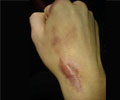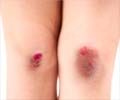The effectiveness and value of an increasingly popular treatment used in the treatment of long term wounds
The effectiveness and value of an increasingly popular treatment used in the treatment of long term wounds are questioned in this month’s Drug and Therapeutics Bulletin (DTB).
Topical negative pressure, or VAC Therapy as it is sometimes known, involves first placing a foam dressing, cut to shape, into a wound.A tube attached to a canister at one end and a suction device at the other is then inserted into the foam, to remove excess wound fluid, and the area sealed with a sticky film.
It has been suggested that the procedure might speed up wound healing in various ways, such as by increasing oxygen flow to the wound, removing bacteria and substances that slow wound healing, and boosting the production of chemicals that promote tissue growth.
VAC Therapy has been used for various different types of wound, including bed sores (pressure ulcers), diabetic foot ulcers, venous ulcers, and skin grafts.
But after reviewing the available evidence the DTB concludes that the “clinical effectiveness of this therapy is unclear.”
Many of the studies carried out on the use of the technique have been flawed in some way, so as to “cast doubt on the validity and reliability of the results,” it says.
Advertisement
The treatment may speed up healing in patients with venous ulcers, given bed rest in hospital, but few such patients are likely to be treated in this way, because of cost.
Advertisement
A suction unit typically costs around £39 a day to rent, and it costs around £50 every time the dressing has to be changed (every 48 hours).
Source-BMJ
LIN/B








